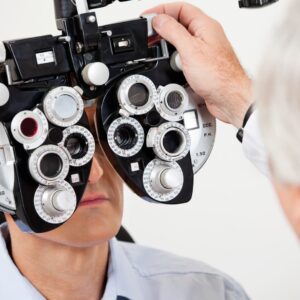Eye tests should be part of your regular health care and can identify any early signs of eye disease such as glaucoma and cataracts.
Eye tests with Chadderton Opticians
Just like a visit to the dentist or a check-up with your GP, an eye test should be part of your regular health checks.


The benefits of a regular eye test
A comprehensive eye test with Chadderton Opticians will identify early signs of eye disease, such as glaucoma and cataract as well as checking for a number of other general health conditions. Early diagnosis can prevent or delay more serious damage. Your optometrist will advise you on how frequently you should have an eye test.
Your eye test procedure
Your eye test will analyse various aspects of your eye health, including your lifestyle, current prescription, eye pressure and muscle strength – all of which helps your optometrist to formulate a detailed report. We also offer home eye care to qualifying patients.
History and lifestyle
You’ll complete a health and lifestyle questionnaire, as many health conditions and lifestyle choices can have an impact on your vision. Armed with this information, your optometrist can then offer you the best care and advice.
Visual acuity testing
During this part of your assessment, you’ll read differently-sized letters and symbols on an eye chart to show your optometrist how well you can read from a variety of distances.
Tonometry
A tonometer blows a puff of air at your cornea and measures intraocular pressure (IOP). Your IOP levels are then used to calculate if you are at risk of glaucoma or other eye conditions, such as retinal detachment and cataracts.
Autorefraction
A computer-controlled machine will calculate how light passes through your eyes to identify your approximate prescription strength. This can then be used by your optometrist as a starting point.
Focimetry
An examination of your current glasses by your optometrist will find out your prescription strength.
Extraocular muscle
Your optometrist will hold a pen in front of your face and ask you to follow it with your eye, without moving your head, to determine the strength and flexibility of your eye muscles.
Refraction
This part of the test measures your sight. Your optometrist calculates your prescription strength, comparing the current prescription of your glasses to your latest focimetry reading to identify any changes.
Dilated retinal exam
You’ll be given eye drops to enlarge your pupils, so that your optometrist can view your eye from the inside. This places particular focus on the retina, which contains the light sensitive cells that help our brain process what we see.
Slit lamp exam
A microscope and a small beam of light are used to closely examine the areas at the front of your eye, including the cornea, eyelids, iris and lens, in greater detail.

